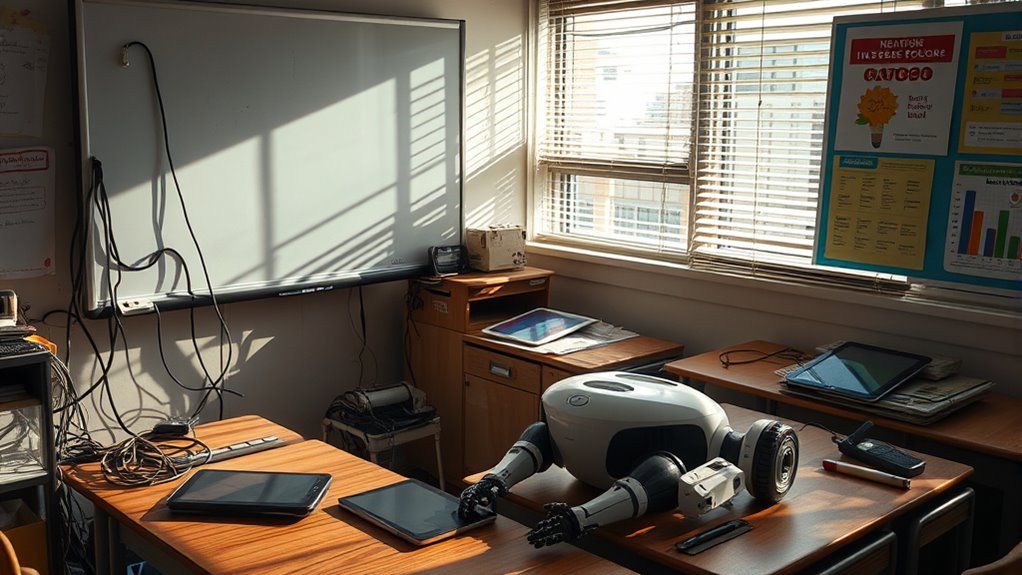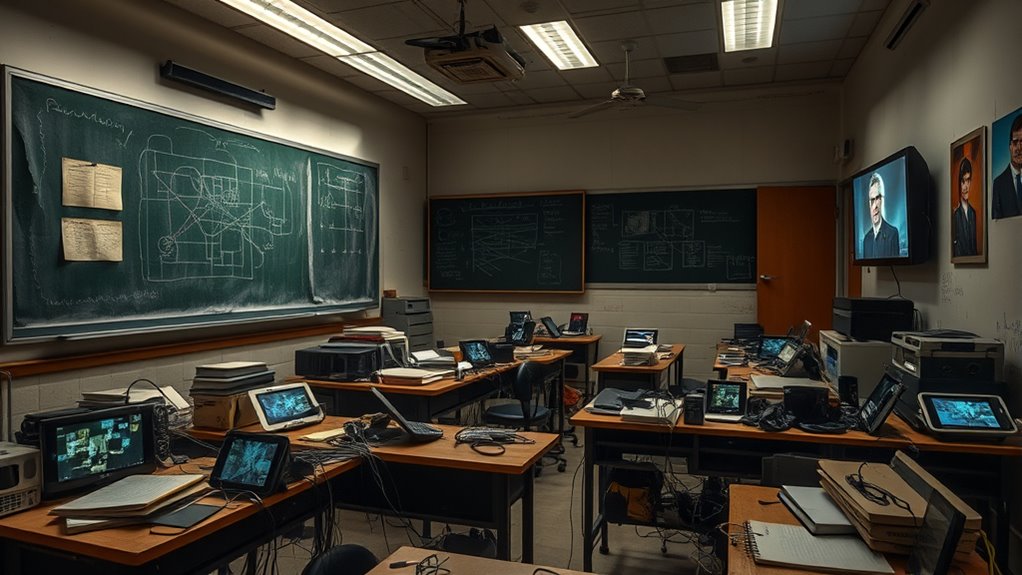Many education tools overpromise results without solid proof, often relying on flawed studies or fake reviews. You might have seen tech that’s unused or misaligned with your classroom needs, leading to frustration and decreased student engagement. Poor training and implementation make things worse, while government evaluations are rare. These failures teach us that future AI in education must prioritize rigorous testing, genuine usefulness, and proper support. Keep exploring to see how these lessons can shape AI’s next steps.
Key Takeaways
- Overpromising ed-tech tools often lack rigorous, independent validation, leading to ineffective solutions that AI can learn to avoid.
- Poor alignment and implementation of classroom software highlight the need for AI-driven customization and teacher support.
- Excessive screen time and low engagement caused by flawed tech emphasize AI’s role in fostering meaningful, human-centered interactions.
- The prevalence of fake reviews and unverified claims underscores AI’s potential to enhance transparency and trustworthy evaluations.
- Limited teacher training on tech integration suggests AI could provide personalized, adaptive guidance for effective classroom use.

Despite the rapid adoption of educational technology, many classroom tools fall short of their promises. You might have seen claims that certain systems boost retention or improve student success, but the truth is often more complicated. For example, Purdue’s Course Signals claimed to increase retention by 21%, yet later studies revealed reverse causality, casting doubt on its actual impact. This pattern repeats across many learning analytics systems, which are often built on flawed studies that overstate benefits. Without strong validation, it’s hard to trust their claims, yet most educators rarely demand rigorous evidence before adopting new tools. In the UK, only 7% of ed-tech companies conduct randomized controlled trials, and just 12% pursue third-party certification. Meanwhile, in the US, fewer than 12% of educators request peer-reviewed evidence—leaving many tools unvetted and unreliable. The Horizon Report has warned for years about the overoptimism surrounding ed-tech, yet many schools continue to invest in unproven solutions. You should also be aware of how much ed-tech remains underused or misfit. In the US, a staggering 67% of education software licenses sit unused, and 98% aren’t used intensively. Most pedagogical tools don’t fit classroom needs; 85% of the reviewed 7,000 tools are poorly aligned or implemented incorrectly. Many of these tools also fail to meet federal standards, with less than 20% of top tools compliant. Fake online reviews make it even harder to assess quality, and governments rarely step in with independent evaluations, leaving schools to navigate a confusing market. Beyond these issues, the negative effects on student engagement are clear. Teachers report declines in motivation, focus, and joy, as students become overwhelmed by hundreds of apps and excessive screen time. Studies show that too much tech use correlates with lower grades and weaker school connectedness. Nearly 19% of students experience symptoms linked to problematic tech use, especially among females. Parents frequently observe children feeling apathetic or disinterested in tech-heavy curricula. These issues highlight how technology can unintentionally harm the very learners it aims to support. Additionally, the lack of rigorous testing contributes to the proliferation of ineffective tools, as many developers prioritize market share over educational value. Finally, many teachers aren’t prepared to integrate tech effectively. Most receive minimal training, leaving them ill-equipped to align tools with their instructional styles. Many ed-tech solutions assume student autonomy or group work, not traditional teacher-led classrooms, so they often fail to boost engagement or learning gains. This misalignment diminishes the technology’s potential, resulting in shallow implementations that neglect core instructional needs. Recognizing these failures can guide the next phase of AI development, ensuring it addresses real classroom challenges rather than repeating past mistakes.
Frequently Asked Questions
What Are the Most Common Reasons for Classroom Tech Failures?
You often face classroom tech failures because of insufficient teacher training, making you hesitant or unable to use new tools effectively. Limited access to devices and unreliable internet disrupt lessons, while misaligned technology doesn’t fit your teaching style. Student distractions and classroom management issues also cause problems. Without proper support, infrastructure, or tailored solutions, tech struggles to enhance learning, leaving both you and your students frustrated and disengaged.
How Can Educators Prevent Tech Flops in the Classroom?
You can prevent tech flops by embracing proper training, even if it seems time-consuming. It’s ironic how neglecting ongoing professional development often leads to underused gadgets. Invest in aligning tools with your teaching goals, involve yourself early in tech choices, and seek continuous support. Standardize equipment and routines to avoid confusion, and gather student feedback. When you treat tech as a pedagogical partner, you’ll reduce failures and truly enhance learning.
Are There Successful Examples of Classroom Tech Implementation?
Yes, many classrooms successfully integrate technology by using devices that align with lesson goals, like interactive whiteboards and tablets, which boost engagement and test scores. Teachers who actively incorporate digital tools and receive proper training see better student performance and motivation. You can replicate this success by choosing appropriate tech, embedding it into lessons, and providing ongoing support. This approach creates a dynamic learning environment that benefits both students and educators.
How Do Student Feedback Influence Tech Upgrades?
Student feedback directly influences tech upgrades by highlighting what works and what doesn’t. You might notice that developers improve interfaces based on your ease of use reports, or add features to personalize learning experiences. Your input helps identify distractions or gaps in tools, prompting iterative refinements. By sharing your experiences, you guarantee that technology evolves to better engage, support, and meet your learning needs, making digital tools more effective and user-friendly.
What Emerging Technologies Show Promise Despite Past Failures?
Bright, bold breakthroughs like AI-powered learning platforms, virtual reality, and adaptive assessment tools show real promise despite past pitfalls. You can harness these innovations to create compelling, customized classrooms that foster engagement and equality. By focusing on inclusive design, proper training, and thoughtful integration, you turn technological turbulence into transformative teaching tools. Embrace these emerging technologies to elevate education and empower every student to succeed.
Conclusion
As you reflect on these tech flops, imagine a classroom once filled with enthusiastic students, now silent, overwhelmed by failed gadgets. These missteps, like broken bridges, show what not to build as AI evolves. Yet, they also serve as guiding lights, illuminating the path forward. By learning from past errors, you can help shape a future where technology supports, rather than stumbles over, education’s true potential. It’s a lesson in progress, not perfection.









